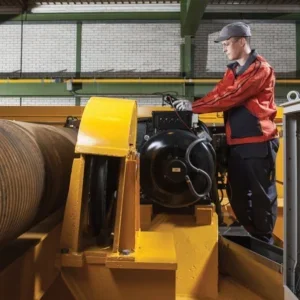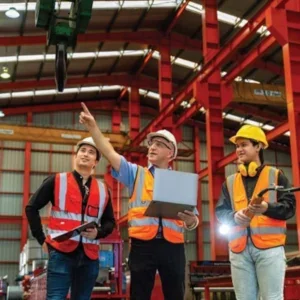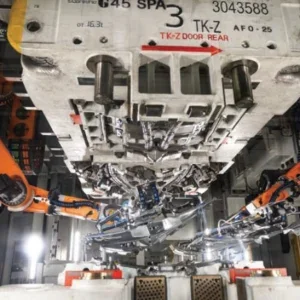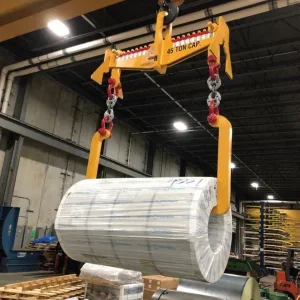Nuclear projects have long been controversial and complicated, and the modern nuclear market is reflective of the scientific, regulatory, and PR environments of particular countries. While the global push to shift to clean energy like solar and wind has opened a debate regarding whether or not nuclear energy is “clean”, the fact remains that nuclear still plays a vital role in both electricity generation – the World Nuclear Association says that in the United States, the world’s largest nuclear energy producer, nuclear power plants supply 20% of all electricity – and in the creation of medical radioisotopes.
These and other factors are creating both opportunities and challenges for hoist equipment manufacturers and distributors that serve the nuclear industry.
Nuclear trends are often region-specific. Robert O’Connor, director of nuclear operations for Whiting Corporation in Monee, Illinois, USA, says that while China is building nuclear plants to power its electrical grid, France is closing its nuclear power plants. Meanwhile, other countries are taking a middle-ground approach of simply maintaining existing plants.
“There’s a lot of maintenance and upkeep happening,” O’Connor says. “A lot of these plants were only designed to run for 40 years, and now suddenly they have to run for an extra 40 years, so they’re in upgrade mode. The American power grid is based on nuclear, so the plants have to keep running.”
With polar cranes in particular, O’Connor says, there is very little demand for new installations. The major components of the polar cranes and other hoists are fixed in place and built to last, although there is some innovation taking place in the form of electrical control upgrades and small trolley replacements.
One of the common factors across all applications, countries, and clients in nuclear is a strong emphasis on safety and security, which is an area of significant growth. O’Connor says that cybersecurity in particular is a concern that is directing, and in many cases hampering, technological development. Many companies are deliberately setting up roadblocks against innovation out of concerns around hacking and cyber threats.
“A lot of new technology hasn’t taken off in nuclear due to cybersecurity concerns,” he says. “Anything electronic, or remote controlled, or accessed via a network, they have concerns about. If the customer base was willing to allow this technology, we could do remote diagnostics and monitoring from a safe distance without climbing up cranes or going into high radiation areas. They’re slowly starting to get on board with some of the new technologies with the next generation of workers.”
Fred Waugh, regional manager of the nuclear and Ohio branches of Whiting Services Inc., says monitoring technology is one of the few areas where clients are welcoming new innovations. Whiting’s trademarked TrackRunner cameras, for instance, are capable of performing complete surveys of polar cranes while providing a live video feed. And in high radiation areas, some nuclear plants are using drones to inspect for leaks and read metres.
Waugh notes that training new hoist operators is another area of technological innovation in nuclear:
“A lot of plants are having a problem finding qualified operators during outages.
The experienced operators used to travel from outage to outage, but a lot of them are retiring now. So when training new operators, they’re doing laser scans of the containment in order to do virtual operator training.”
Whiting is currently starting work on a new crane for the Brunswick Nuclear Generating Station in North Carolina. The new crane is an updated version of the original crane that was installed in 1971.
Regional Trends
The nuclear industry’s regionalized nature can make it difficult for companies to secure a diverse array of contracts in a single country: China is predominantly new builds, France is mostly decommission work, and Canada has primarily been a maintenance market with some decommissions of research and prototype reactors.
In the United Kingdom, however, there are three different generations of nuclear projects currently underway, which means the domestic market can offer a diverse project portfolio. Simon Pykett, general manager of Penny Hydraulics’ specialist division Penny Nuclear in Clowne, Derbyshire, says each of these types of projects has its own unique driving factors.
“Legacy sites must be decommissioned to ensure the safe storage of nuclear waste,” Pykett says. “These sites must also be taken into a state known as care and maintenance, the period after the site has been fully decommissioned but remains secure and closely monitored. Every piece of the site must be carefully taken to pieces, examined, and processed, which creates a need for many specialized pieces of lifting and handling equipment.”
The United Kingdom, Pykett says, has 15 operational nuclear reactors that collectively supply just over 20% of UK electricity. However, almost half of the UK’s nuclear power generation capacity will be retired by 2025, which means new reactors will be required to meet the country’s power generation needs.
“The only new nuclear build is at Hinkley Point C in Somerset,” Pykett says. “This is a major infrastructure project that requires the largest mobile crane ever built. Known as Big Carl, the crane is over 250 metres tall, can lift over 5,000 (metric) tonnes, and will help to assemble the reactors and their surrounding enclosures.”
Penny Nuclear supports all stages of the nuclear plant lifecycle, but the majority of the company’s recent projects have involved decommissioning end-of-life plants. Pykett says one of the most significant barriers to new builds is the large upfront capital investment required.
While decommissioning projects are government-funded, new builds in the UK rely on funding from private for-profit companies. Penny Nuclear is typically involved in eight to ten key projects at any time, ranging from tool development to bespoke design-build. One recent project involved the development of a fully automatic drum grab for moving low level waste drums to a new site.
“The grab can engage and disengage automatically, and it has inbuilt systems to prevent release if the drum inadvertently contacts an unforeseen object,” Pykett says.
“While drum grabs are widely deployed, they often rely on manual intervention from an operator – a luxury not available in the nuclear industry where the operator must remain a safe distance away from the radioactive drum.”
The Penny Nuclear drum grab can be operated from a distance, features fine tuned positioning controls that are accurate to within a few millimetres, and includes on-board high-definition cameras that provide visibility even when the drum is lowered into a vault five metres deep.
Pykett says that he expects the nuclear market to grow. Of the four key divisions at Penny Hydraulics, Penny Nuclear is the division that expects to see the most growth. However, the nuclear industry is tightly regulated, and therefore the growth will be slow and steady rather than fast and sudden.
“Diversifying into the nuclear arena must be seen as a long-term investment,” Pykett explains. “It will almost certainly challenge and reshape the way a business operates.”
The nature and variety of nuclear projects currently in demand isn’t only region-specific; there are also predictable trends in both the public and the private sector. Kevin Johnston is the president of J&R Engineering, a lifting equipment manufacturer based in Mukwonago, Wisconsin, USA. Johnston says that in the United States, private companies primarily perform decommissioning work, while the federal government is continuing to invest in nuclear power, storage, and research.
“The government hasn’t stopped using nuclear because it powers (the navy’s) warships,” Johnston says. “But the government is also in the research area. They’re supplying research grants for small nuclear reactors to a few companies.”
Johnston says the nuclear industry hasn’t seen much of an impact from the COVID-19 pandemic, and J&R Engineering still has personnel travelling across the United States. Nuclear plants provide electricity and medical isotopes, making the nuclear sector an essential service; therefore, maintenance work must continue to happen on a regular schedule regardless of external factors.
Johnston notes that electricity providers are seeing reduced profits as a result of a drop in commercial electricity use during the pandemic, even in spite of increases in residential electricity use. However, he also says parts of the nuclear industry have been stagnant for some time:
“I haven’t heard of any new plants being built. There are quite a few plants still operating, and plants are being decommissioned. I do know that the navy is storing spent fuel in Idaho, and any increase in new storage facilities would boost the industry.”
Much of J&R Engineering’s work involves designing and manufacturing cask transporters, training on-site staff, and providing site management services.
The company recently introduced an improved generation of cask transporters with a new modular design. These modular cask transporters can be disassembled, transported between work sites on trailers, and then reassembled at their destination. Johnston says this design is easier and less costly to move between sites without compromising on safety.
J&R Engineering also recently completed an upgrade project in England designed to improve safety:
“We just put in rubber-tyred multiplesteering axles in a plant in England,” Johnston says. “They’re single-failure-proof because we have Lift-N-Lock cam locking technology. We have hydraulic cylinders that lift the load. Around the cylinders are mechanical booms, and the booms have cam locks that will hold the load in the event of a loss of hydraulic pressure.”
Alternative Reactors Grow
Recent technological advances in reactor fuel systems are creating opportunities for new hoist installations. Jason Schulz, crane business segment leader for PaR Systems in Shoreview, Minnesota, USA, says that a recent set of leaps forward in safety technology has now given companies the opportunity to innovate in other areas.
“In the past couple of decades, compliance with (U.S. Nuclear Regulatory Commission) Regulation 0554 has been the driving force that created a lot of new crane upgrade opportunities for the handling of nuclear materials,” Schulz says. “A lot of those upgrades have been completed by now, so we’re seeing growth and opportunity in new nuclear technologies like small modular reactors and alternative reactors.”
Schulz says that molten salt reactors are creating demand for nuclear hoists and specialized material handling equipment. While he says he can’t name names, Schulz notes that PaR Systems has been involved in and is supporting molten salt reactor projects.
One project PaR Systems is currently involved in is providing crane and hoist designs for use with small modular reactors at NuScale Power in Portland, Oregon, USA.
The NuScale plant design includes 12 small modular reactors and, when complete, will output a total of 924 megawatts of electricity. The reactor building crane will be an integral part of the plant’s process for refuelling the 12 reactors.
“The crane will lift a 950 (US) ton reactor,” Schulz says. “It’s going to position a reactor into a refuelling stand, and then repeat that operation 11 times. At approximately 45- to 60-day intervals, it’ll pick up another reactor and start the refuelling process all over again. It’s almost like a continuous refuelling cycle over the life of the plant’s operation.”
The reactor building crane will need to carefully move, and manipulate the placement of, each small reactor as part of the refuelling process. During refuelling, PaR Systems’ hoisting technology must orient each reactor module into a vertical position within the designated assembly and disassembly robotic equipment structures.
PaR Systems is incorporating its trademarked TensileTruss methodology as part of the hoisting system. TensileTruss’ mobile tool platform consists of an upper and a lower platform that are connected by six wire ropes run on six independent hoists.
“Using the TensileTruss system is a semiautomated process,” Schulz says. “The hoist system will orient the module into true vertical position. US commercial nuclear plants do not operate their cranes and refuelling equipment on fully automated systems. They want some kind of human acknowledgement in between certain commanded motions. The NuScale reactor building crane will operate in a similar manner.”
Schulz says PaR Systems has high expectations of the nuclear industry and is seeing a growing interest in small modular reactors. The company is currently bidding on a variety of significant opportunities in nuclear. While the COVID-19 pandemic initially prompted a slowdown from March to June, Schulz says there is now ample work to be had.
Adversity is also driving innovation in nuclear storage. Cost considerations are changing the way companies store used nuclear fuel, which is creating new challenges and opportunities for nuclear cranes and hoists. Curtis Roberts, director of communications and press officer for Orano USA in Bethesda, Maryland, USA, says that companies have found cost efficiencies by using larger casks.
“Cost is a driving factor, especially when decommissioning a shut-down reactor site,” Roberts says. “When you have a larger canister and shielded cask, not only can you put more nuclear material inside, but you also take fewer trips. There’s also a lot of extra effort going into repurposing the cranes at these shut-down reactors and ensuring they can do what they need to do for this new end-of-lifecycle purpose.”
Roberts’ colleague James Seals, vice president of field services at Orano’s nuclear logistics subsidiary Orano TN in Columbia, Maryland, USA, says that as used fuel canisters and casks have increased in capacity, utilities have continued to invest into lifting equipment upgrades or replacements to keep up with lifting capacity requirements for used nuclear fuel. Many older models of hoist are only designed to lift about 100 US tons (90 metric tonnes), Seals says, while the used fuel canisters inside the transfer casks have increased in weight to between 115 and 125 US tons (104 to 113 metric tonnes) when loaded.
Orano’s NUHOMS dry storage systems for used nuclear fuel canisters are also changing, which is creating a need for hoists that can reach larger heights. As of going to press, Orano TN is currently working on the first array of the two-tiered NUHOMS MATRIX storage system and associated hoist. Orano broke ground on the array in late summer of 2020 and expects the first canisters to be loaded into the storage modules in July or August 2021.
The NUHOMS MATRIX is a two-storey horizontal storage system made of concrete and steel that is designed to safely increase storage density at nuclear reactors’ onsite used fuel storage facilities. The 28-foot-high (8.5-metre-high) concrete array stores used fuel canisters up to 16 feet (4.88 metres) in length and approximately 75 inches (1.91 metres) in diameter.
Seals says the storage system’s height required the development of a safe lifting mechanism that could exert lateral force without destabilizing itself. Orano accomplished this by developing an improved rail system as well as a gantry system. Four lift towers can be synchronized to rise in parallel or can be adjusted individually as needed in order to level the load. Rails and a skid enable horizontal movement of the canisters into the concrete storage module.
“There’s a means of attaching the lift crane to the face of the module to add lateral stabilization to it,” Seals says. “This allows personnel to minimize dose while the cask is loaded with used nuclear fuel.
For lift tower height, consideration must be given to the arms coming down to engage the transfer skid, so the operational height when fully raised is about 40 feet.”
The system’s control center, consisting of both controls and video feeds, can be located separate from the loading module, with cables run from the control center to the hoist.
Seals says that while new large-scale nuclear sites in the United States likely won’t be built until after the completion of nuclear energy units Vogtle Three and Vogtle Four in Waynesboro, Georgia, USA in 2023, research and development projects in advanced and small modular reactors continue. Orano is currently involved in the development of a consolidated interim storage facility for used nuclear fuel. This facility would consolidate fuel being stored at over 70 shut down, decommissioned, and operational nuclear facilities across the United States.
The nuclear sector is a promising and challenging market. Nuclear trends tend to be country-specific, with some countries like China focused on building new plants, others like Canada prioritizing maintenance of existing installations, and regions like France making a push to decommission nuclear reactors. In markets where nuclear power plants are being shuttered, the required decommissioning work is creating demand for hoists; indeed, even decommissioned nuclear facilities must still be maintained as a matter of public safety.
The applications of nuclear technology also extend beyond power generation to consumer goods, medicine, military projects, and space exploration. While some companies expect the nuclear sector to hold steady, others are predicting growth and opportunity as pent-up demand for delayed upgrades is unleashed. Companies that are willing to make longterm investments will likely find the nuclear industry an enticing challenge.






